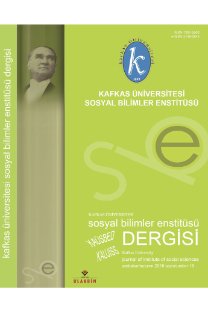EXPLORING PARAPHRASING AMONG L2 ACADEMIC WRITERS
İkincil Dilde Akademik Yazarların Açımlama Süreçlerinin İncelenmesi
___
Cheng, F. W., & Unsworth, L. (2016). Stance-taking as negotiating academic conflict in applied linguistics research article discussion sections. Journal of English for Academic Purposes, 24, 43-57. 10.1016/j.jeap.2016.09.001Cumming, A., Kantor, R., Baba, K., Erdosy, U., Eouanzoui, K., & James, M. (2005).Differences in written discourse in independent and integrated prototype tasks for next generation TOEFL. Assessing Writing, 10(1), 5-43. Doi:10.1016/j.asw.2005.02.001
Curry, M. J., & Lillis, T. M. (2010). Academic research networks: Accessing resources for English-medium publishing. English for Specific Purposes, 29(4), 281-295. Doi:10.1016/j.esp.2010.06.002
Davis, M. (2013). The development of source use by international postgraduate students. Journal of English for Academic Purposes, 12(2), 125e135. https://doi. org/10.1016/j.jeap.2012.11.008.
Flowerdew, J., & Li, Y. (2007). Language re-use among Chinese apprentice scientists writing for publication. Applied Linguistics, 28(3), 440e465. https://doi. org/10.1093/applin/amm031.
Gentil, G. (2011). A biliteracy agenda for genre research. Journal of Second Language Writing, 20(1), 6-23. Doi: 10.1016/j.jslw.2010.12.006
Grabe, W., & Zhang, C. (2013). Reading and writing together: A critical component of English for academic purposes teaching and learning. TESOL Journal, 4(1), 9-24. Doi: 10.1002/tesj.65
Hinkel, E., (2004).Teaching Academic ESL writing, Lawrence Erlbaum Associates, Inc. Publishers. Mahwah, New Jersey,
Hirvela, A. (2011). Writing to learn in content areas: Research insights. Learning-towrite and writing-to-learn in an additional language, 159-180.
Hirvela, A., & Du, Q. (2013). “Why am I paraphrasing?”: Undergraduate ESL writers' engagement with source-based academic writing and reading. Journal of English for Academic Purposes, 12(2), 87-98. Doi:10.1016/ j.jeap.2012.11.005
Hood, S. (2008). Summary writing in academic contexts: Implicating meaning in processes of change. Linguistics and Education, 19(4), 351-365. Doi:10.1016/j.linged.2008.06.003
Hyland, K. (2003). Second language writing. New York: Cambridge University Press.
Ivanic, R. (2004). Discourses of writing and learning to write. Language and education, 18(3), 220-245. DOI: 10.1080/09500780408666877
Kang, J. Y. (2005). Written narratives as an index of L2 competence in Korean EFL learners. Journal of Second Language Writing, 14(4), 259-279. 10.1016/j.jslw.2005.10.002
Keck, C. (2006). The use of paraphrase in summary writing: A comparison of L1 and L2 writers. Journal of Second Language Writing, 15(4), 261-278. Doi: 10.1016/j.jslw.2006.09.006
Lam, T. C., & Bengo, P. (2003). A comparison of three retrospective self-reporting methods of measuring change in instructional practice. American Journal of Evaluation, 24(1), 65-80. DOI: 10.1177/109821400302400106
Leki, I. (2007). Undergraduates in a second language: Challenges and complexities of academic literacy development. Mahwah, NJ: Erlbaum.
Leki, I., & Carson, J. (1997). “Completely different worlds”: EAP and the writing experiences of ESL students in university courses. TESOL quarterly, 31(1), 39-69. 10.2307/3587974
Lillis, T., & Curry, M. J. (2010). Academic writing in a global context: The politics and practices of publishing in English. London/New York: Routledge. Loi, C. K., Lim, J. M. H., & Wharton, S. (2016). Expressing an evaluative stance in English and Malay research article conclusions: International publications versus local publications. Journal of English for Academic Purposes, 21, 1- 16. 10.1016/j.jeap.2015.08.004
Macqueen, S. (2012). The emergence of patterns in second language writing: A sociocognitive exploration of lexical trails. Bern, Switzerland: Peter Lang. Melzer, D. (2009). Writing assignments across the curriculum: A national study of college writing. College composition and communication, 61(2), W240. Retrieved from http://www.ncte.org/library/NCTEFiles/Resources/Journals/ ccc/0612-dec09/ccc0612writing.pdf
Moore, T., & Morton, J. (2005). Dimensions of difference: A comparison of university writing and IELTS writing. Journal of English for Academic Purposes, 4(1), 43-66. 10.1016/j.jeap.2004.02.001
Neumann, H., Leu, S., & McDonough, K. (2019). L2 writers’ use of outside sources and the related challenges. Journal of English for Academic Purposes, 38, 106-120. Doi: 10.1016/j.jeap.2019.02.002
Pecorari, D., & Petrić, B. (2014). Plagiarism in second-language writing. Language Teaching, 47(3), 269-302. Doi: 10.1017/ S0261444814000056
Rohs, F. R., & Langone, C. A. (1997). Increased accuracy in measuring leadership impacts. Journal of Leadership Studies, 4(1), 150-158. DOI: 10.1177/107179199700400113
Shi, L. (2004). Textual borrowing in second-language writing. Written communication, 21(2), 171-200. 10.1177/0741088303262846
Shi, L. (2010). Textual appropriation and citing behaviours of university undergraduates. Applied Linguistics, 31, 1–24. Doi: 10.1093/applin/amn045
Storch, N. (2012). Incorporation of source material: The effect of instruction. TESOL in Context, 22, 38–55.
Storch, N. (2012). Incorporation of source material: The effect of instruction. TESOL in Context, 22(1), 38. Retrieved from https://search.informit.com.au/ fullText;dn=596244689496152;res=IELHSS
Sun, Y. C. (2009). Using a two-tier test in examining Taiwan graduate students’ perspectives on paraphrasing strategies. Asia Pacific Education Review, 10(3), 399-408. DOI: 10.1007/s12564-009-9035-y
Swales, J. M., & Feak, C. B. (2004). Academic writing for graduate students: Essential tasks and skills (2nd Ed.) Ann Arbor, MI: University of Michigan Press. Thompson, C., Morton, J., & Storch, N. (2013). Where from, who, why and how? A study of the use of sources by first year L2 university students. Journal of English for Academic Purposes, 12, 99–109. Doi: 10.1016/j.jeap.2012.11.004
Wette, R. (2010). Evaluating student learning in a university-level EAP unit on writing using sources. Journal of Second Language Writing, 19(3), 158- 177. 10.1016/j.jslw.2010.06.002
Wette, R. (2017). Source text use by undergraduate post-novice L2 writers in disciplinary assignments: Progress and ongoing challenges. Journal of Second Language Writing, 37, 46-58. 10.1016/j.jslw.2017.05.015
- ISSN: 1307-5500
- Yayın Aralığı: 2
- Başlangıç: 2008
- Yayıncı: Kafkas üniversitesi Sosyal Bilimler Entitüsü
RUSYA’NIN KARADENİZ FAALİYETLERİ ve BATUM’DA İSKELE İNŞASI GİRİŞİMİ
BURDUR MÜZESİ’NDEN BİR RÖLİKER HAÇ
İSTİHDAMDA YER ALMAYAN KADININ KAMUSAL ALANDAKİ GÖRÜNMEZLİĞİ
KROMLEKLİ YAPILARA KARS’TAN BİR ÖRNEK: BAYKARA MEZARLIĞI
MİMARİYE MALZEME TEMİN YERLERİNDEN ÇOK BİLİNMEYEN BİR ALAN: ERZURUM SAZLIĞI
ERZURUM’DA ÖNEMLİ BİR URARTU KALESİ: HARAMİ KALE
Mustafa KARAGEÇİ, Yavuz GÜNAŞDI
İSRAİL-FİLİSTİN MÜCADELESİNİN KÖKENİNE İLİŞKİN BAZI DÜŞÜNCELER
TÜRKÇE SÖZ DİZİMİNDE ARA SÖZ/ARA CÜMLELERİN ÖĞE AÇIKLAMA İŞLEVİ ÜZERİNE BİR İNCELEME
CELİL MEMMEDGULUZÂDE’NİN ESERLERİNDE ERMENİLER
HAYRİYE MELEK HUNÇ’UN ESERLERİNE İSLÂMİ FEMİNİZM ÇERÇEVESİNDEN BİR BAKIŞ
